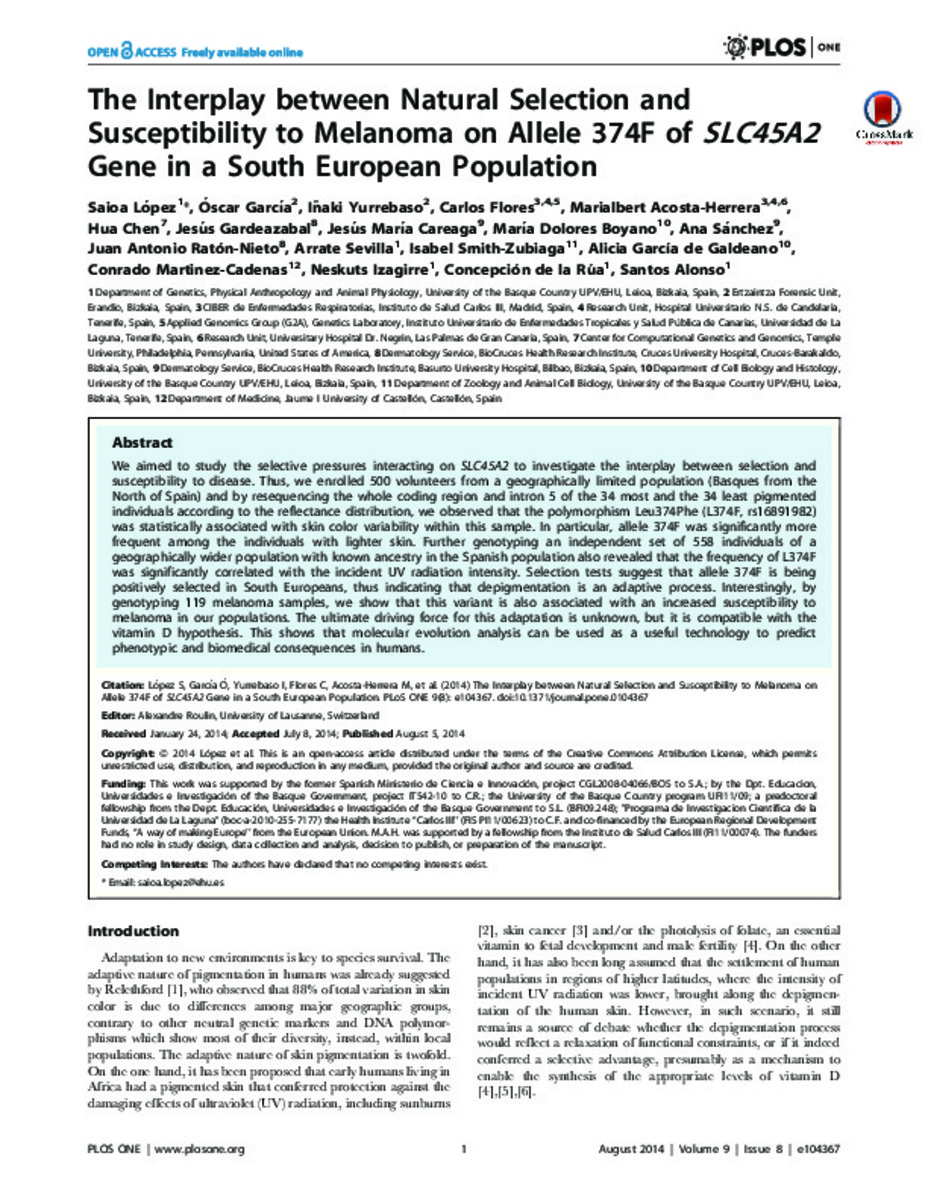Mostrar el registro sencillo del ítem
The Interplay between Natural Selection and Susceptibility to Melanoma on Allele 374F of SLC45A2 Gene in a South European Population
| dc.contributor.author | López, Saioa | |
| dc.contributor.author | García, Oscar | |
| dc.contributor.author | Yurrebaso, Iñaki | |
| dc.contributor.author | Flores, Carlos | |
| dc.contributor.author | Acosta-Herrera, Marialbert | |
| dc.contributor.author | Chen, Hua | |
| dc.contributor.author | Gardeazabal, Jesús | |
| dc.contributor.author | Careaga, Jesús María | |
| dc.contributor.author | Boyano, Dolores | |
| dc.contributor.author | Sánchez, Ana | |
| dc.contributor.author | Ratón-Nieto, Juan Antonio | |
| dc.contributor.author | Sevilla, Arrate | |
| dc.contributor.author | Smith-Zubiaga, I. | |
| dc.contributor.author | García de Galdeano, Alicia | |
| dc.contributor.author | Martinez-Cadenas, Conrado | |
| dc.contributor.author | Izagirre, Neskuts | |
| dc.contributor.author | de la Rúa, Concepción | |
| dc.contributor.author | Alonso, Santos | |
| dc.date.accessioned | 2015-06-15T17:39:43Z | |
| dc.date.available | 2015-06-15T17:39:43Z | |
| dc.date.issued | 2014 | |
| dc.identifier.citation | López S, García Ó, Yurrebaso I, Flores C, Acosta-Herrera M, Chen H, et al. (2014) The Interplay between Natural Selection and Susceptibility to Melanoma on Allele 374F of SLC45A2 Gene in a South European Population. PLoS ONE 9(8): e104367. doi:10.1371/journal.pone.0104367 | ca_CA |
| dc.identifier.issn | 1932-6203 | |
| dc.identifier.uri | http://hdl.handle.net/10234/123683 | |
| dc.description.abstract | We aimed to study the selective pressures interacting on SLC45A2 to investigate the interplay between selection and susceptibility to disease. Thus, we enrolled 500 volunteers from a geographically limited population (Basques from the North of Spain) and by resequencing the whole coding region and intron 5 of the 34 most and the 34 least pigmented individuals according to the reflectance distribution, we observed that the polymorphism Leu374Phe (L374F, rs16891982) was statistically associated with skin color variability within this sample. In particular, allele 374F was significantly more frequent among the individuals with lighter skin. Further genotyping an independent set of 558 individuals of a geographically wider population with known ancestry in the Spanish population also revealed that the frequency of L374F was significantly correlated with the incident UV radiation intensity. Selection tests suggest that allele 374F is being positively selected in South Europeans, thus indicating that depigmentation is an adaptive process. Interestingly, by genotyping 119 melanoma samples, we show that this variant is also associated with an increased susceptibility to melanoma in our populations. The ultimate driving force for this adaptation is unknown, but it is compatible with the vitamin D hypothesis. This shows that molecular evolution analysis can be used as a useful technology to predict phenotypic and biomedical consequences in humans. | ca_CA |
| dc.format.extent | 13 p. | ca_CA |
| dc.format.mimetype | application/pdf | ca_CA |
| dc.language.iso | eng | ca_CA |
| dc.publisher | Public Library of Science | ca_CA |
| dc.relation.isPartOf | PLoS ONE, August 2014, Volume 9, Issue 8, e104367 | ca_CA |
| dc.rights | © 2014 López et al. This is an open-access article distributed under the terms of the Creative Commons Attribution License, which permits unrestricted use, distribution, and reproduction in any medium, provided the original author and source are credited. | ca_CA |
| dc.rights | Attribution 4.0 Spain | * |
| dc.rights.uri | http://creativecommons.org/licenses/by-sa/4.0/ | * |
| dc.title | The Interplay between Natural Selection and Susceptibility to Melanoma on Allele 374F of SLC45A2 Gene in a South European Population | ca_CA |
| dc.type | info:eu-repo/semantics/article | ca_CA |
| dc.identifier.doi | http://dx.doi.org/10.1371/journal.pone.0104367 | |
| dc.rights.accessRights | info:eu-repo/semantics/openAccess | ca_CA |
| dc.relation.publisherVersion | http://www.plosone.org/article/fetchObject.action?uri=info:doi/10.1371/journal.pone.0104367&representation=PDF | ca_CA |
Ficheros en el ítem
Este ítem aparece en la(s) siguiente(s) colección(ones)
-
MED_Articles [641]
Articles de publicacions periòdiques
Excepto si se señala otra cosa, la licencia del ítem se describe como: © 2014 López et al. This is an open-access article distributed under the terms of the Creative Commons Attribution License, which permits unrestricted use, distribution, and reproduction in any medium, provided the original author and source are credited.








